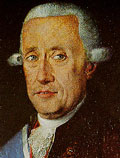 |
José Antonio Nolasco Moñino y Redondo
b. 21 Oct 1728, Murcia
d. 30 Dec 1808, Seville |
| Title: |
Presidente interino de la Junta Central Suprema Gubernativa de los Reinos de España y de las Indias (Interim President of the Governing Supreme Central Junta of the Kingdoms of Spain and of the Indies) [1] |
| Term: |
25 Sep 1808 - 1 Oct 1808 |
| Chronology: |
24 Sep 1808, elected, preparatory meeting of the Junta, casa del Antonio Valcárcel y Pío de Saboya, Príncipe Pío, Aranjuez [2] |
|
25 Sep 1808, installation of the Junta, Capilla del Real Palacio, Aranjuez [3] |
| Title: |
Presidente de la Junta Central Suprema Gubernativa de los Reinos de España y de las Indias (President of the Governing Supreme Central Junta of the Kingdoms of Spain and of the Indies) [1] |
| Term: |
1 Oct 1808 - 30 Dec 1808 |
|
1 Oct 1808, elected, meeting of the Junta, Aranjuez [4] |
|
30 Dec 1808, died [5] |
| Names/titles: |
Conde de Floridablanca [from 26 Oct 1773] |
| Biography: |
Son of a retired army officer, who served as ecclesiastical notary in Murcia; was educated at Colegio de San Fulgencio; studied law at the University of Orihuela; worked as lawyer in Madrid; earned doctorate from the University of Salamanca (1752); was appointed (1766) a fiscal (ministerial official) of the Council of Castile (Consejo de Castilla); investigated the Esquilache riots (1766) and won a reputation as a supporter of the king's reformist policies; took active role in the expulsion of the Jesuits (1767); was made envoy to Rome (1772-1776), where he succeeded in securing the support of the Pope Clemens XIV in suppressing the order; appointed first secretary of state (19 Feb 1777 - 28 Feb 1792) by King Carlos III; carried out a thorough reform of the Spanish bureaucracy, culminating in creation of the Supreme Council of State (1787); involved himself in university reform and improved press liberties; encouraged public works in Madrid aimed at rebuilding the city; secured alliances with Prussia and Russia; improved relations with Portugal; concluded trade agreements with Morocco and the Ottoman Empire; supported the First Coalition against the revolutionary French Republic, but failed to prevent discrediting of the liberal movement in Spain, which he headed; was stabbed by a French priest who was a revolutionary sympathizer at Aranjuez (1790); ousted on charges of embezzlement (1792); was imprisoned at the castle of Pamplona (1792-1794); acquitted in 1794 and retired to his estates; was called to join a new central government created at Aranjuez to oppose the French occupation; approved as Interim President of the Governing Supreme Central Junta (25 Sep 1808 - 1 Oct 1808) and then elected to the office of president of the same body (1 Oct 1808 - 30 Dec 1808); left Aranjuez (1 Dec 1808) before the city was seized by the French and was installed at Seville (16 Dec 1808); succumbed to illness under the strain of the trip and died 30 Dec 1808. Biography source: [6] |
| |
| [1] |
Also in official use: Presidente (interino) de la Junta Central Suprema Gubernativa del Reino, Presidente (interino) de la Junta Central Suprema y Gubernativa del Reino, Presidente (interino) de la Junta Central Suprema y Gubernativa de España e Indias, Presidente (interino) de la Junta Suprema Central de Gobierno de España e Indias. |
| [2] |
"Derecho parlamentario español", ed. by Manuel Fernández Martín (Madrid: Imp. de los Hijos de J.A. García, 1885), Tomo I, p. 376. |
| [3] |
Gazeta extraordinaria de Madrid, del jueves 29 de Setiembre de 1808. Núm. 129. PP. 1217-1219; Gazeta de Madrid, del martes 18 de Octubre 1808. Núm. 135. PP. 1313-1315. |
| [4] |
Gazeta de Madrid, del martes 18 de Octubre 1808. Núm. 135. PP. 1304-1305. |
| [5] |
Gazeta del Gobierno, del viérnes 27 de Enero de 1809. Núm. 5. PP. 70-71. |
| [6] |
"El Conde de Floridablanca", by Cayetano Alcázar Molina (Madrid: Aguilar, 1935). |
|
Image: portrait by pintado por F. Goya (Museo del Prado, Madrid) |

